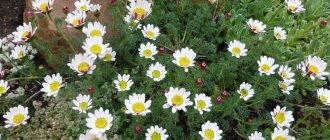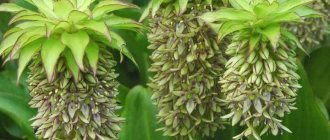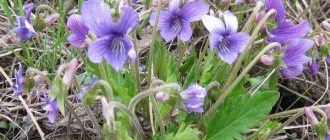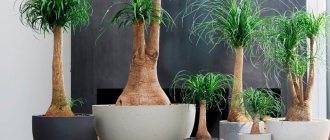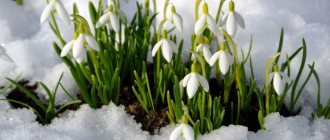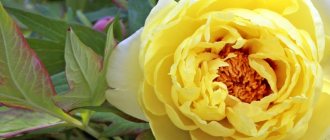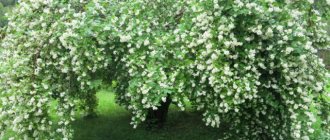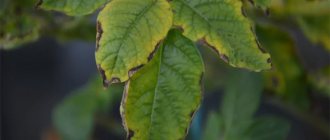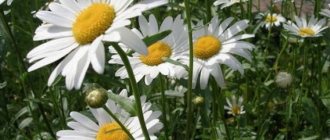Anacyclus
The plant really strongly resembles chamomile in appearance. The variety has about 10 subspecies , which are annual and perennial. The petals of the opened bud have a double color: they are white on the inside and pink on the outside. The flower reaches a diameter of 5 cm.
Basically, the varieties look like small bushes creeping along the ground. As a member of the aster family, anacyclus is subject to the solar rhythm: it opens at dawn and closes during sunset.
Arctotis
A rather tall crop, which sometimes grows up to 130 cm. In difficult conditions, the flower develops poorly and grows only up to 25 cm. The species is divided into two subspecies: stochafolium and hybrid.
Both named subspecies are characterized by unusual buds with petals colored red or bronze at the center with a gradual transition to yellow. The buds open only in sunny weather, and you won’t be able to admire them in the rain.
Venidium
These are white, pink, orange or yellow flowers similar to daisies. They have a brown or dark red core. When open, the bud reaches 10 cm in diameter , and the length of the stem is between 70-80 cm. The species is rarely grown in open ground, more often it can be found in home pots and flowerpots. Flowering begins at the end of June and continues until the end of September.
External signs of daisies
Traditional Matricaria is a herbaceous crop with an upright, branched stem, flowering in snow-white baskets. It is with this plant that inexperienced gardeners often confuse other representatives of the Asteraceae. They really have a lot in common:
- straight, branched shoots;
- pinnately dissected leaf blades;
- saucer-shaped inflorescences;
- baskets consisting of short reed flowers surrounded by long marginal petals;
- subtle aroma;
- unpretentiousness.
Matricaria is a herbaceous plant with an upright, branched stem
Gatsania
The flower has an incredible variety of shades: yellow, lilac, red, orange, etc. There are also two-color and striped varieties. Externally, gatsaniya really resembles a chamomile, only with brighter and more colorful petals. Gradient varieties, where one color gradually gives way to another, do not allow you to take your eyes off the bush.
Under natural conditions, there are about 40 species that are resistant to frost, direct sunlight, drought and high temperatures. Flowering starts at the beginning of summer and continues until night frosts. The height of the bush is within 30-40 cm. The flower retains its appearance for a long time after cutting.
Gatsania is grown in open ground, pots and flowerpots. It combines well with other plants in the flowerbed and looks impressive when planted alone. The species is used to decorate paths, borders and rock gardens.
Basic growing rules
Ampelous unpretentious perennial flowers for the garden
Now you need to understand how doronicum is grown from seeds and when the flower needs to be planted on the site.
Preparing and sowing seeds
Cellular trays can be used as planting containers. An earth mixture is poured into them - coarse sand and peat (in a ratio of 1 to 1). Up to 3 seeds are sown in each cell, the containers are covered with film, and placed in a place inaccessible to sunlight.
Deadlines
Sowing seeds should be done in mid-spring - in April. The seedlings should spend a month to a month and a half at home. In early June they can already be planted on the site.
How to care for seedlings
Seedlings need systematic ventilation, removal of condensation and moistening of the soil mixture. When the first shoots appear, the level of illumination needs to be increased. Weak tall plants (more than 4 cm) need to be pruned. One of the most persistent sprouts should be left in each compartment.
Seedling care
14 days before planting, you need to start hardening the seedlings daily.
Note! The most effective way to grow yellow chamomile is the seedling method.
Site selection and soil preparation
Semi-shaded areas with loose, moderately moist soil are ideal for the flower. It is not recommended to plant chamomile close to the trunks of mature trees. The soil should be dug deeply (a quarter of a meter deep) in the autumn. During planting, feed the soil with rotted manure.
Planting in open ground
The planting holes should be at a distance of half a meter from each other. The size of the hole should correspond to the size of the seedling with a ball of earth. The flower is placed in the hole, sprinkled, compacted in the soil, and then slightly moistened.
Gerbera
The plant is similar in structure to a chamomile, but has purple, yellow, cherry, orange, cream and classic white petals. Such diversity attracts gardeners; resistance to adverse conditions, as well as wide possibilities for use in bouquets, also play an important role.
There are double gerberas, and their numerous petals are tubular, curly and pointed. The species is grown outdoors and at home. Flowering starts in the summer months and lasts until November. The exact dimensions of the bush and the open bud depend on the variety.
Crops that bloom in autumn
Representatives of the flora, capable of decorating gardens not only in summer, but also in the autumn months, are resistant to night frosts and daytime coolness. Their bright beauty is especially noticeable on gloomy, stormy days.
- There are about 100 species of gerberas. They differ in colors and parameters. Due to their vitality, they are preserved in flower arrangements for a long time. Depending on the species, they have terry, tubular, pointed and multiple petals. They bloom throughout the summer until late autumn.
- Chrysanthemum is an autumn flower. The most popular variety is Korean. However, there are varieties that closely resemble the humble chamomile. Chrysanthemum petals are lilac, yellow, purple, violet, red, lilac. Among them there are both perennials and annuals with different parameters.
- Aster can bloom in different months. This feature depends on the species and varietal. The alpine species is the earliest, flowers bloom in late spring. Fall varieties of asters are the New Belgian and New England varieties. As they grow, they become more lush and voluminous, which adds to their attractiveness for gardeners.
- Rudbeckia is a widespread crop. A large flower with a dark brown center and few yellow petals is attached to a high stem. Pink, orange, cream and red-brown shades are sometimes found. This plant has about 40 bred hybrid varieties. The tallest specimens reach 200 centimeters. Unpretentious to the soil in which it grows.
Doronicum
The second name of the species is Kozulnik. There are about 40 varieties, but often only 10 are used. The height of the bush varies in different varieties from 0.5 to 1 meter. The flowers are yellow and quite large - the diameter reaches 10 cm. Flowering begins in May and lasts on average 1.5 months. At the same time, the plant can be pleased with the repeated release of buds in mid-summer or early autumn.
When cut, the flower retains its attractive appearance for a long time. You should know that the plant is poisonous. It is not recommended to plant Doronicum under trees - it will be suppressed.
How to protect against diseases and pests
Yellow chamomile is very tenacious and practically does not suffer from pests and diseases. In addition, Doronicum tolerates both high and low temperatures equally well.
The most vulnerable place of this chamomile is the leaves. Without treatment, they become prey to slugs and snails due to their soft texture and lack of natural protection. In order to prevent pest invasion, you need to treat the plant with herbicide in time.
All other diseases can be easily managed with regular watering and fertilizing. The plant’s immunity copes with most diseases on its own.
Yellow chamomile is often used for decorative areas. Flowerbeds with doronicum look fresh and lively. Bright yellow accents look good among both dark and light flowers, and variations in the diameters of the inflorescences and the height of the stems allow you to create the ideal composition.
Calendula (marigold)
The following daisy-like flowers are incredibly popular among people who have a local area. They belong to the Astrov family and are distinguished by their unpretentiousness to external conditions. Depending on the variety, the bush grows from 20 to 65 cm in height .
The open buds are quite compact, the petals are deep orange. Having planted marigolds in the garden once, you will not need to buy seeds for the next year - the plant actively reproduces by self-seeding, and if its spread is not limited, it will quickly occupy the entire free territory.
Botanical description and characteristics
Yellow chamomile is an undemanding herbaceous perennial that belongs to the Asteraceae family. Its scientific name is Doronicum.
This plant has beautiful golden flowers. They are 4-12 cm in diameter. The height of the plant can reach 25-140 cm - it all depends on the chosen variety.
The basket-shaped flowers contain tubular petals in the center. At the same time, along the edges there are reed petals, which are placed in 1-2 rows. The plants are decorated with thin peduncles that have practically no foliage.
After flowering has finished, garden daisies quickly lose their decorative properties. Therefore they need to be trimmed.
Yellow meadow daisies are characterized by two types of leaves - stem and basal. The lower foliage forms a basal rosette. The stem leaves do not have petioles and are alternately arranged. The stems are simple or poorly branched. They are characterized by sufficient flexibility.
Inflorescences are presented in the form of single baskets. However, sometimes the corymbose inflorescence includes 2-6 pieces. The achenes have an elongated shape. They can be smooth or hairy.
The bushes are characterized by rapid development. They quickly become quite lush. Flowers can grow in the same place for several years.
You can choose a place on the plot and grow yellow daisies there for a long time
Coreopsis
The flower has yellow petals with a jagged edge and brown spots at the base. Pedicels grow up to 60-100 cm in height, depending on the variety. The diameter of the opened bud is within 3-7 cm. Flowering begins in mid-summer and lasts 2-2.5 months. Flower baskets can be regular or double, and the shade of the petals also varies.
The crop is suitable for growing in large front gardens and massive flower beds.
Flowers that look like daisies in your garden - photos, names
Many of us love flowers that look like daisies. The first flower I drew in childhood looks exactly like this – a yellow center with petals around the edges. I immediately remember my childhood with the naive fortune-telling “loves or doesn’t love.”
Flowers with petals like those of a chamomile - white, blue, yellow, are charming in their simplicity, pleasing to the eye, unpretentious in care, and look harmonious in flower beds and areas. They are equally good in single or mixed plantings. However, their colors and sizes can be completely different.
These are not types of chamomile, but completely different flowers. Let's look at the most popular of them.
Anacyclus
Anacyclus can easily be confused with chamomile because they are actually very similar. This flower has approximately 10 varieties and can be either an annual or a perennial. Anacyclus blooms towards the end of May and continues to produce color until late July/early August.
This representative of the Asteraceae family reacts to lighting: in the evening the flowers close, and open in the morning. Most often you can see Anacyclus depressus in garden beds - it is considered the most common species and is grown as a perennial.
From the category of annuals, the most favorite (frequently found) are Anacyclus clavatus (club-shaped) and Anacyclus radiatus (radiant). The white petals of Anacyclus depressus are pink underneath, which distinguishes it from chamomile.
This is a low, creeping plant with strong stalks. The flowers themselves are approximately 5 cm in diameter.
Anacyclus, species, photo:
Doronicum
This is an unpretentious, cold-resistant flower that can become a bright decoration of your site with the arrival of May. Doronicum flowering lasts about 1.5 months, but the likelihood that it will delight you with its flowers again in mid-summer or closer to autumn is very high.
Its genus consists of 40 varieties, but only 10 of its species are the most popular. Doronicum is also called “kozulnik”. Depending on the variety, it can grow up to 50 cm or 1 m in height. Its flowers are large, from 8 to 10 cm in diameter. If you cut doronicum and put it in a vase, it will last for a very long time without losing its freshness.
You should know that this flower is poisonous (its ground part).
One piece of advice: do not plant doronicum (perennial roe grass) under trees - they suppress it, shortening the flowering time.
Doronicum:
Chrysanthemum Bacardi
This relatively recently bred variety (2004) is often used for making bouquets and various flower arrangements. Chrysanthemums of the Bacardi variety have a yellow center and white petals, which gives them the maximum resemblance to a sunny daisy.
In addition to the “classic” colors, flower petals can be yellow, soft purple, red, cream, or pink.
The simple structure of the buds gives florists a creative flight of fancy - the inflorescences are painted in different shades, sprinkled with glitter and other small decor.
This plant looks very attractive both in single plantings and in company with other garden crops. Cut flowers remain fresh for a long time; Bacardi can also be grown indoors, in a pot.
Before planting a chrysanthemum in open ground, you should select sunlit areas for it in advance, since when shaded it may not produce flowers.
Watering should be plentiful, but there should be no excess moisture.
Chrysanthemum Bacardi:
Daisies
This is another flower that looks like a daisy. A particularly pronounced similarity is observed in the variety with a yellow core and white petals.
Naturally, this is not the only option for the natural color of daisies; they can be bright crimson, red, lilac, orange, deep yellow, etc. The buds can be of different sizes and shapes.
This flower itself is not tall, blooms in early spring, and blooms until frost sets in. Despite its external fragility, it is quite hardy and not capricious.
Daisy, photo:
Only photos of flowers that resemble a daisy in their shape
AstersAnemone from the ranunculaceae family, what is not the red daisyBrachicoma - blue daisyGaillardiaGeleniumHeleopsis looks like a yellow daisyGeleopsis variegatedDorotheanthusCalendula (marigold)Coreopsis (lenk)Blue Lobelia, small marigolds in the backgroundEchinacea Red Riding HoodEchinaceaEchinacea purpurea UrsiniaHelichrysum (immortelle)Dimorphotheca notched or orangeDimorphotheca yellowDimorphotheca hybrida similar to purple daisyZinnias (majors )Annual dahlias Osteospermum Peretrum maidens
Look, study, choose - and you will definitely find “your” flowers that look like daisies!
Cosmea
The plant often evokes associations of summer warmth and comfort. Its distinctive feature is its low maintenance and self-seeding. Once you remember what these colorful daisies are called and look like, they can be distinguished in private flower beds, as tapeworms on lawns, in city park areas and along borders. A lush carpet of greenery and bright buds will decorate the garden, covering bare areas of the territory and emphasizing straight lines.
The crop easily copes with prolonged drought and heat, is undemanding to the presence of various substances in the soil, and is resistant to frost. The petals come in many shades of red and purple, and white varieties are also found. The buds are located on straight stems growing within 0.7-1.5 meters. Cosmea is used as a tapeworm and in the company of other plants. If there are empty spaces in the flowerbed, this flower often saves the day, since it manages to easily and quickly cover all the flaws.
What flowers, similar to chamomile, are medicinal?
Chamomile inflorescences and leaves have pronounced medicinal properties and are used to treat inflammatory processes, diseases of the stomach and intestines, skin, and genitourinary system. Tea made from the flowers of the plant helps cope with sleep disorders, depression and stress. In addition, flower infusion strengthens the immune system.
Reference! Plants such as cornflower and echinacea have similar properties.
The main characteristic of medicinal echinacea is strengthening the body's defenses. The plant protects the cardiovascular system, cleanses blood vessels from plaque and increases their elasticity. Echinacea tea normalizes sleep and treats human depression, protects against premature aging and improves metabolic processes.
Nivyanyk
In fact, this is chamomile, namely its garden variety. Nilet belongs to the aster family and is often grown in our gardens. It is chosen due to the lack of special requirements for care, soil, and watering. It tolerates frost well. The bush grows up to 120 cm, the exact figures depend on the variety.
Flowering is accompanied by the opening of a white bud up to 10 cm in diameter with a yellow center. The process is repeated twice during the summer season: in May or June, and a second time in August or September.
Possible problems in growing
Although doronicum is not a capricious flower, problems with its cultivation still sometimes arise.
Problems with leaves
A common cause of damage to daisy foliage is the activity of slugs. They love to eat green leaves. To prevent their appearance, the soil around the plant should be sprinkled with hot ground pepper. This will prevent pests from crawling to the flower.
Important! At the end of flowering, some of the leaves dry out and lose their aesthetics. In this case, dry foliage should be cut off.
Pests
Yellow chamomile is often attacked by aphids and thrips, which suck the juices from the flower. To combat them, various insecticides are used, which effectively help get rid of small pests.
Pests
Diseases
In case of excessive watering, gray rot may appear on the plants. In this case, the plants need to be thinned out, infected parts removed, and watering adjusted.
When overmoistened, the flower is also susceptible to rust and powdery mildew. In this case, you need to reduce watering and remove damaged parts of the flower.
Signs of improper care
If Doronicum has not been planted for a long time, then its flowers may be too small. To rejuvenate, the plant should be dug up and divided into parts.
Problems can also arise with too much light. Although Doronicum is a light-loving plant, if exposed to excessive sunlight, the flowers can become significantly smaller.
Growing Doronicum in open ground is quite simple. Even an inexperienced gardener can cope with this task. By providing the plant with proper care, it will be especially pleasant to enjoy the lush flowering of your garden pet.
Osteospermum
These flowers are exactly like daisies, only with purple or red petals. The varieties with white flowers are especially similar. It is recommended to plant in open areas exposed to direct sunlight. At the same time, osteospermum shows high resistance to life in regions where cloudy and rainy weather prevails.
The crop is grown in the form of annual or perennial plantings. The height of the bush varies between 25-100 cm, the opened bud reaches a diameter of 4-10 cm.
Summer flowers
The most popular plants that do not require special care are daisy flowers. In flower beds, they can alternate between varieties, which will give the space a magnificent look throughout the summer.
- Doronicum (roeberry) is a cold-resistant flower. Blooms in the last month of spring. If it is not planted under trees, it may re-bloom during the season. There are 40 species in its genus, only ten of which are considered particularly popular. Large flowers sometimes reach 10 centimeters in diameter and a height of 50 to 100 centimeters. The above-ground part of the plant is poisonous.
- Leucanthemum, or cornflower, is a herbaceous perennial. It has large inflorescences framed by white petals. This is a variety of common garden chamomile. There are several varieties of cornflower with double or needle-shaped flowers. It blooms all summer long.
- Marigolds (calendula) are a popular garden crop among gardeners. Its main advantage is propagation by self-sowing, so annual planting is not required. The petals of the flower are bright, they are characterized by an orange tint. The height of the bushes depends on the variety. The low-growing species has a stem length of up to 30 cm, a tall one - up to 65 cm. Marigolds are not only beautiful, but also have healing properties.
- Cosmea is an annual herb that grows in central Russia. Due to its unpretentiousness and independent reproduction, it is very popular among amateurs. Its petals have many shades. The rarest species is the chocolate cosmos, so named because of the chocolate aroma exuded by this crop. The flowers have a dark burgundy hue. The plant is not adapted to harsh climatic conditions, so it is extremely difficult to grow.
- Daisy-flowering helichrysum, or immortelle. Despite the fact that its homeland is the Australian and African continents, outdoor helichrysum is perfectly adapted to the Russian climate. The inflorescences are represented by hard multi-colored scales.
- Echinacea is a flower with a hemispherical convex center and multi-colored petals. It grows slowly, but lives longer than chamomile. Purple echinacea is known for its medicinal properties due to its antibacterial and anti-inflammatory effects.
- Pink coreopsis begins to bloom in midsummer. This native of the North American continent thrives in cool climates. The cut plant remains fresh for a week when placed in a container filled with water. The lush bush is strewn with small pink flowers of various shades.
- Anacyclus (anacilus) - in some cases the letter “k” is not pronounced. It combines features inherent in its species and similarities with chamomile. The outer part of the inflorescence is white and yellow, while the underside of the petals is decorated with a bright pink tint. This feature gives the culture a very elegant look. They prefer to bloom under the sun's rays. On low shoots, these unusual flowers look large, although they are small. In alternative medicine it is considered an aphrodisiac and a toothache reliever.
- Decorative sunflower differs from its forage counterpart in its modest size. Unlike white chamomile, its petals are rich yellow to orange-red. Small bushes do not exceed 20 centimeters in height. However, there are also large varieties with a maximum height of 5 meters.
- Pyrethrum is a pink flower similar to a daisy. The similarity with it lies in the yellow core. In addition to the main shade, it can have lilac, purple, yellow and white colors, which gives it an incredible resemblance to a white beauty. Tolerant to cold, prefers open areas. In herbal medicine it is used for ailments such as headaches and arthritis.
Pyrethrum
Another double of the chamomile, which is a highly branching bush, 20-50 cm high. The opening buds can reach 8 cm in diameter, their petals are colored white, pink, crimson, red and lavender. The flower is grown as an annual and perennial crop and has an effective ability to self-sow. Planting is possible in almost any soil, but waterlogging and stagnation of water should be avoided.
Flowering begins in May and continues for a long period. The aroma is strong and quite specific.
Rudbeckia
The flower belongs to the tall category, the minimum height of the bush is 50 cm, and the maximum reaches 2 meters. The plant has no special care requirements; moreover, it is perennial and can decorate the garden in one place for up to 5 years.
The daisy-like flowers come in yellow, pink, scarlet, orange and cream. There are two-color species, where the darker base becomes lighter as it approaches the edge of the petal. There are 40 varieties in total.
Ursinia
The shape of the flower is similar to a chamomile, but the color of the petals is very different. They are mostly golden with a hint of orange. The color is bright and rich, easily attracting attention. It is noteworthy that the inside of the flower is lighter than the outside. For example, a petal that is yellow on the inside will be brownish-purple on the back. The opened buds have a diameter of 5-6 cm.
The shoots grow up to 30-60 cm, covered with dark green foliage. The crop is grown both annual and perennial. It is resistant to negative temperatures and is undemanding to living conditions. Flowering continues until night frosts appear.
Chrysanthemum
A perennial or annual plant with many varieties. Flowers are located on a separate stem or are included in massive inflorescences. The petals are cream, lilac, yellow, purple and lilac. The height of one branch varies depending on the variety, in rare cases it can grow up to 160 cm. The plant is stable after cutting.
The chrysanthemum variety Bacardi deserves special attention. You should remember the name and look at the photo, because chamomile-like flowers can be used to create a wide variety of compositions. The variety has white, densely set petals and a yellow center, which together gives an incredible similarity. There are up to two dozen buds on one large stem, so literally 3-5 branches allow you to form a lush, beautiful bouquet.
In addition to the standard color, the petals can be red, yellow, pink, or cream. This flower is popular among florists - its inflorescences are painted in various shades, sprinkled with sparkles, and decorated with ribbons.
The Bacardi variety is grown outdoors and at home. It is placed on sunny lawns and provides abundant watering.
Types of daisies - flowering border perennials
Today, the classification of daisies includes more than 25 varieties of this cute flower: from the pharmacy chamomile, known to everyone, to the original blue daisy, the petals of which, as the name implies, can have unique shades - from sky blue to deep blue.
Perennial blue chamomile
Chamomile - perennial or annual
Depending on the variety, chamomile can be either annual or perennial. For example, the garden varieties Banana Cream and Snegurka are perennial varieties, while chamomile is an annual plant.
Description of colors
Chamomile (in Latin “Matricária” - “mother herb”) is a flower, amazing in its simplicity, belonging to the Asteraceae or Asteraceae family.
Chamomiles can be semi-double or double, their petals can differ from each other: there are flowers with thin and wide, curved and straight. Moreover, varieties have been bred that have no petals at all. Some varieties have a slight odor, while others have no odor at all.
For your information! Many gardeners wonder how many petals a chamomile has. There is no exact answer to this question, the whole point is that each flower is individual, and the number of petals, even within one variety, can range from 10 to 34 pieces.
Information about where daisies grow deserves special attention. Thanks to small seeds that the wind can blow over fairly long distances, all over the world you can see neat clearings or single bushes, pleasing the eye with their simplicity. Another important factor that allows daisies to feel equally good in Africa and the USA, as well as in Australia and Eurasia, is their unpretentiousness and ability to quickly adapt to a wide variety of climate conditions.
The classic field chamomile has white petals
Beginning gardeners often wonder when field daisies bloom. Flowering begins in the second half of April, continues throughout the warm period and ends in September with the onset of cold weather. Most of the flowers open in the summer, during June and July. However, in regions where the climate is mild and warm, for example, in the Caucasus, Crimea and the Mediterranean, daisies bloom quite early, you can admire them already at the end of February.
Note! Each bush produces more and more inflorescences throughout the summer months, making it seem as if the flowering is continuous. The most popular representative of the family is field chamomile, which has a number of useful qualities.
Thus, scientists specializing in the science of pharmacognosy were able to find out that the essential oil included in the inflorescences has antiseptic and disinfectant properties and has a beneficial effect on the mucous membranes. Speaking about the beneficial properties of chamomile, one cannot fail to mention vitamins and minerals that can strengthen and nourish hair, giving it shine and a healthy appearance.
The most popular representative of the family is field chamomile, which has a number of useful qualities. Thus, scientists specializing in the science of pharmacognosy were able to find out that the essential oil included in the inflorescences has antiseptic and disinfectant properties and has a beneficial effect on the mucous membranes. Speaking about the beneficial properties of chamomile, one cannot fail to mention vitamins and minerals that can strengthen and nourish hair, giving it shine and a healthy appearance.
Dried flowers for collection
Important! The components that make up the chamomile collection help get rid of colds, improve the functioning of the gastrointestinal tract, eliminate redness and flaking, and can cure itching. It is not surprising that gardeners from different parts of the world plant low-maintenance plants on their plots.
Listed below are the most attractive varieties of daisies that will decorate any, even the smallest garden plot
It is not surprising that gardeners from different parts of the world plant low-maintenance plants on their plots. Listed below are the most attractive varieties of daisies that will decorate any, even the smallest garden plot.
Echinacea
A perennial with properties beneficial to the human body. There are only 10 types of Echinacea, the most popular of which is purple. Its petals can be not only purple, but also red, cream and yellow. The daisy-like flowers consist of slightly downturned petals and a convex center.
The height of the stem in some cases reaches 140 cm. Reproduction occurs by seed and vegetative methods. Flowering begins in mid-summer and continues until September. The plant produces buds from the second year of life.
It is recommended to plant in sunny areas; shade and even partial shade are unacceptable. There are no special requirements for the soil; only light sandy soil will not work. Echinacea grows in one place for about 5 years, then a transplant will be required.
Daisy-like flowers
Despite the general similarity, the differences lie in the details. Twin plants have their own names, belong to different genera, have unique colors, sizes and care requirements.
Anacyclus
A low-growing plant with creeping stems grows up to 10 cm, growing in small groups. The baskets, about 50 mm in diameter, have snow-white petals with a crimson underside surrounding a golden center. Reacting to light, the flower closes after sunset and blooms only in the morning. Flowering occurs in May-July, sometimes lasting until August. In gardening, three types of anacyclus are most often found: depressum, clavate, radiate.
Anacyclus - a low-growing plant with creeping stems
Arctotis
Bear's ear, as this crop is also called, comes in four types:
- stochastic;
- acaulescent;
- short-stemmed;
- hybrid.
Its height ranges from 0.2 to 1.3 m, and the plant itself is distinguished by multi-colored buds measuring 5-10 cm, which hide in the absence of sun. Thus, the color is dominated by white, yellow, scarlet, purple or orange shades. Arctotis blooms from mid-summer until the onset of cold weather. It is quite unpretentious, tolerates drought well, and does not require frequent watering.
Arctotis is often called bear's ear
Gatsania
African chamomile is a low-growing plant, the height of which does not exceed 30-40 cm. Its highlight is colored baskets 50-90 mm in size, often with a gradient color. The bright yellow core may be surrounded by marginal petals of orange, violet, carmine, pastel or raspberry colors, with a distinct dark brown base. Gatsaniya does not need special care, maintaining its decorative qualities all summer and until the first frost.
Helichrysum daisy flower
An unpretentious creeping crop that grows up to 8-10 cm and forms a wide bush with a diameter of about half a meter. Short stems covered with small leaves have a bluish tint. From June to August, snow-white baskets with a yellow-light green “eye” appear on them. Among flower growers, several types of helichrysum are most popular: awl-leaved, helmet-shaped, bract-shaped, selago, milford, coral-shaped.
Gerbera
A medium-sized flower with a thick, bare stem grows up to 0.6 m and differs from chamomile in its varied colors. Its tint palette contains all colors except blue. Also, in most species the center is not yellow, but golden brown, chocolate or grayish. Buds with a diameter of 5-30 cm are double, semi-double or single. Flowering lasts from early summer to late autumn.
Gerberas are quite light-loving and love warmth, and therefore they are often moved indoors for the winter.
Gerbera Helichrysum daisy flower
Gatsania
Venidium
In our latitudes, only one variety of Venidium is most often found - lush. This is an erect plant up to 0.8 m high, with a fleecy stem and foliage. Starting from the second half of summer, the flower throws out snow-white, purple, lemon-yellow or coral baskets about 10 cm in size. The tubular petals are usually dark brown, framed by an orange rim. The heat-loving crop grows best on loose, light soils where there is no stagnant moisture.
In our latitudes there is one variety of Venidium - lush
Doronicum
Kozulnik is represented by several species, of which the three most famous are:
- Columnae;
- Altai (altaicum);
- Cluse (Clusii).
The height of the plant ranges from half a meter to a meter, and sometimes even a little higher. Doronicum blooms for a month and a half, starting from the end of spring, in large baskets 6-10 cm in size. The color of the needle-shaped petals and convex core is bright golden, for which the flower is often called yellow daisy. The perennial stands well when cut, does not tolerate shade, and can also bloom again in the second half of summer.
Doronicum is called yellow daisy
Calendula
Marigolds have not only high decorative qualities, but also medicinal properties. They grow from 10 to 60 cm, forming a lush carpet of sunny shades. The buds, which can be simple or double, are colored orange-red or bright lemon. Flowering occurs in June-August, sometimes lasting until September. The culture is not capricious, easily propagated by self-sowing, and also prevents the appearance of insect pests in the garden plot.
Calendula buds are orange-red or bright lemon in color
Coreopsis pink
Unlike other species, which have all shades of yellow, pink coreopsis is distinguished by purple petals surrounding an amber-honey “eye”. It grows from 0.6 to 1.1 m and blooms from mid-summer to early autumn with small simple baskets with a diameter of 20-50 mm. The plant loves open, well-lit areas and does not tolerate stagnant moisture. With proper care, it can grow without transplantation for 5-6 years without losing its decorative qualities.
Cosmea
Of the two dozen varieties in the central zone, the double-pinnate species is most often cultivated. This is a fairly unpretentious crop with a size of 0.5 to 1.5 m. It is distinguished by thin stems covered with leaves similar to dill. It blooms in small simple or terry baskets of snow-white, lilac or scarlet shades.
The least common species is chocolate cosmos. It has a rich burgundy-brown color and a subtle chocolate aroma.
Daisies
The white varieties of these flowers are most similar to daisies, but purple, lilac or pink shades of daisy buds are also found. The miniature plant grows no higher than 0.3 m, forming a compact flower bed with a lush rosette of leaves at the base. Flowering begins in spring and lasts until the onset of the first cold weather. During this period, the bushes are covered with small, densely packed buds of a double or semi-double structure. Possessing increased hardiness, daisies do not require special care.
Daisies
Cosmea Coreopsis pink
Osteospermum
In the middle zone, this crop is often grown as an annual crop. The height of the bush is from 0.3 m to a meter, and the diameter of the baskets is 4-10 cm. The long marginal petals are usually similar in color to tubular flowers and come in white, scarlet or purple shades. Osteospermum blooms all summer, and in a warm autumn it can retain its decorative qualities until October. The light-loving plant prefers open areas, light soil, and regular watering.
Osteospermum blooms all summer
Nivyanyk
Because of its strong resemblance, this perennial is often called the garden daisy. The culture is quite tall, it can grow up to 1.2 m. It is distinguished by large baskets with a diameter of 10-13 cm, located one on each peduncle. The tubular center is golden-yellow, has a small depression, and long snow-white marginal petals are fanned out around it. The flower is unpretentious to growing conditions and blooms continuously from June to October.
Nielberry is often called garden chamomile
Pyrethrum
Externally, the plant resembles a cornflower, but unlike the latter, the color of the petals of pyrethrum is light pink or crimson. The crop grows just above half a meter, maintaining its decorative qualities throughout the summer. Snow-white species are less common: maiden and shield. Since the perennial quickly adapts to the environment, it cannot be called capricious. The only thing that the flower cannot tolerate is excessive moisture, which leads to stagnation of water.
The color of the petals of pyrethrum is light pink or crimson
Rudbeckia
The autumn crop, which is characterized by late flowering, stands out with its sunny color. The height of the erect bushes reaches 0.9-1.2 m, and the size of simple inflorescences is up to 12 cm. Golden-honey marginal petals, burgundy at the base, surround a burgundy-brown, strongly convex core. Sometimes there are varieties of creamy pink, purple or even dark red. Rudbeckia tolerates cold well and can grow in one place for 5 years.
Jerusalem artichoke
A forage crop that successfully combines table and decorative qualities. Earthen pear, as Jerusalem artichoke is also called, blooms in the second half of summer. The baskets are large, 10-12 cm in diameter, and are distinguished by a rich lemon color. The height of the plant can reach 4 m, but most often it does not exceed 1-1.5 m. A feature of the perennial is its high winter hardiness - even in severe frosts it can winter quietly without additional shelter.
Ursinia
The dill variety is the most popular among our flower growers. The flower, no more than 0.6 m high, has lemon or light orange petals. In this case, the outer part is always darker than the inner. An obligatory element of color is a chocolate-brown rim framing the golden “eye”. The plant blooms with the arrival of summer, retaining the buds until the beginning of autumn.
In the middle zone, ursinia is grown as an annual, and therefore it is dug up in the winter to be planted again in the spring.
Author's advice
Ursinia Jerusalem artichoke Rudbeckia
Felice
A rather capricious crop, which is often called blue daisy. She came to us from South Africa, and therefore does not adapt well to the local conditions. Felicia tolerates drought calmly, but reacts to lack of light by not blooming. The plant is short, rarely grows above 25 cm, but can grow greatly in breadth. The buds are medium in size and consist of sky-blue marginal petals surrounding a bright lemon center.
Felicia buds consist of sky-blue marginal petals
Chrysanthemums
Some varieties of chrysanthemums (for example, Bacardi) are very reminiscent of chamomile. They grow in lush branched bushes from 0.5 m to 1.5 m in height. Starting from the end of summer, the plant is covered with simple snow-white baskets with a light green core. There are also varieties with double or semi-double buds of various colors. The perennial is well suited for cutting, as it can last up to 1.5-2 weeks in a bouquet.
Some varieties of chrysanthemums are very similar to chamomile
